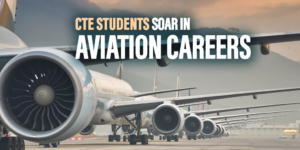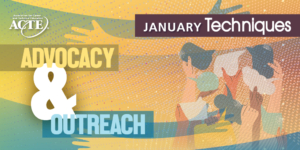Brightly decorated balsa wood gliders soared through the air. Video cameras documented launches, flight paths and time aloft. Working in collaborative teams, student aeronautical engineers designed, constructed, tested, and redesigned their vehicles to meet the challenge. To stay in the air the longest. This was the start of the 2023–24 academic year for Laura Doyle’s high school engineering career and technical education (CTE) class in Westfield, New Jersey. Doyle introduced her students to engineering design through this aviation challenge.
Her students learn how gliders work. They discuss the forces of flight, and they use the prototype glider templates as a rough guide. Students must change the design in some way, so that the entire class isn’t making the same prototype. And they must justify their iterated designs through research. “I like walking around the room and overhearing conversations students are having with each other about balancing wings, moving the center of mass, describing their flight path, and laughing about failed attempts,” Doyle shared.
These are the kinds of challenges that Doyle and other CTE educators seek out: real-world, standards-based, and engaging to spark learners’ creativity and innovation. CTE educators search for constructivist experiences framed in problem-based scenarios, like this activity, to introduce learners to a variety of career pathways and industry demands.
Share more with students about careers in aviation.
Over the next 10 years, as more than 25% of commercial pilots reach the mandatory retirement age, it’s anticipated there will be more than 160,000 job openings for pilots (AeroGuard Flight Training Center, 2023; Aviation Workforce, 2023). The industry is also reporting challenges in filling demands for airplane mechanics. Engaging youth to build the future aviation workforce is a critical industry need (National Academies of Sciences, Engineering, and Medicine, 2019).
Grassroots advocacy efforts are beginning to address shortages in this field. Once disparate groups are coming together with a common goal to increase awareness of careers in aviation. Over its 70-year history, the Experimental Aircraft Association (EAA) has grown from a small group of aviation enthusiasts to an international organization representing a wide spectrum of recreational aviation. In line with the group’s mission to grow participation in aviation by promoting the spirit of aviation, EAA staff and educators from North Carolina State University, Appalachian State University, and the National Institute of Aerospace teamed up to develop a series of aeronautics-themed, integrative STEM activities for K–12 education.
These resources are housed and disseminated through AeroEducate, EAA’s educational platform. Each activity begins with an essential question, incorporates a career component through a real-world scenario, and introduces and reinforces age-appropriate vocabulary. Families, educators and facilitators benefit from background information resources. And posters that illustrate key concepts are available as well.
Effective collaboration expands access.
The collaboration extends beyond EAA and the AeroEducate activity development team. Principal partners, including United Airlines, Siemens and Airbus, provide guidance on industry direction, practical advice to help guide students’ career pathways, and financial support for materials and website development, broadening access and making resources free to all registered users. Additional partners, including Horizon Hobby and NEXTGEN Aviators, support AeroEducate’s dissemination efforts.
Further, to build excitement for careers in aviation, EAA provides free flights to youth aged eight to 17. More than 2.3 million Young Eagles have logged flights. With the continued support of partners, more opportunities for in-person experiences are being planned.
Conclusion
These resources are one tangible outcome of the collaborative efforts of industry, nonprofits, and academia. They demonstrate what can be accomplished when such groups come together with a common goal to solve a shared problem. From aeronautical engineers to sound engineers to air traffic controllers, students learn about a variety of careers. The design-based activities build context for learning through career connections. And they exercise students’ critical and creative thinking skills through the engineering process. Today, they’re building balsa wood gliders, but tomorrow they may be flying their own planes.
Sharon Bowers is a senior STEM education specialist and associate director of the Center for Integrative STEM Education at the National Institute of Aerospace.
Kevin Sutton is an assistant professor in career and technical education at Appalachian State University.
Laura Doyle is an engineering and design teacher at Westfield High School in Westfield, New Jersey.
Rebecca Jaramillo is a senior communications program manager at the National Institute of Aerospace.









